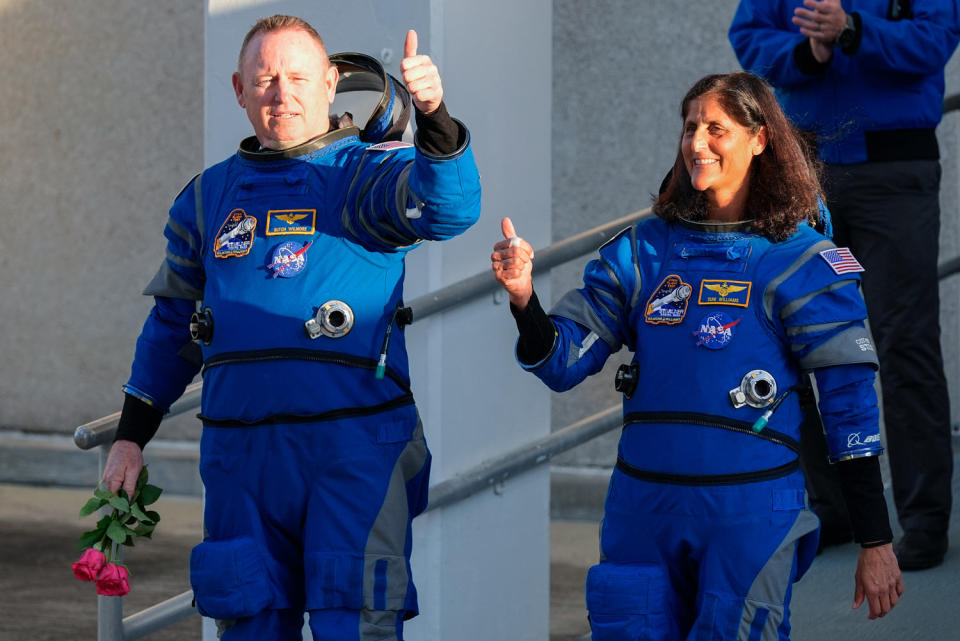NASA is considering keeping the two astronauts who flew Boeing’s capsule to the International Space Station there until February as a result of issues the spaceship encountered midflight.
The agency said Wednesday that it is still evaluating options for how to bring NASA astronauts Butch Wilmore and Suni Williams back to Earth safely, and that no plan has been made yet. But officials acknowledged more openly than before that they may decide to use a SpaceX capsule instead.
“Our prime option is to return Butch and Suni on Starliner,” Steve Stich, manager of NASA’s Commercial Crew Program, said Wednesday in a news briefing. “However, we have done the requisite planning to make sure we have other options open, and so we have been working with SpaceX to ensure that they’re ready to respond.”
Wilmore and Williams arrived at the space station on June 6 on the first crewed test flight of Boeing’s Starliner capsule. The initial plan called for them to stay in space for about a week. But problems with five of Starliner’s thrusters and helium leaking from the capsule’s propulsion system have stranded the astronauts there for more than two months as engineers on the ground gather data about the issues and attempt to troubleshoot.
The mission was designed to be the final step before the agency could certify Boeing to conduct routine crewed flights to and from the ISS. The fate of that process is now up in the air.
NASA did not offer any potential timeline as to when the astronauts might return if they travel back on Boeing’s capsule, but Stich said that a final decision likely needs to be made by mid-August.


In the meantime, the launch of one of SpaceX’s Dragon capsules — which was slated to launch four new crew members to the space station later this month — has been postponed to give NASA and Boeing more time to deal with the Starliner problems.
The SpaceX mission (known as Crew-9) is delayed by about a month. NASA officials said they could alter the plan and send two crew members to space on that vehicle instead of four, then use the capsule to bring Wilmore and Williams home.
Ken Bowersox, associate administrator of NASA’s Space Operations Mission Directorate, said there have been disagreements over how to bring the astronauts home safely.
“I have to admit that sometimes when we get disagreement, it’s not fun,” Bowersox said. “It can be painful having those discussions, but it’s what makes us a good organization, and it’s what will get us to a good decision as we approach that point here in the future. And I don’t think we’re too far away from making that call.”
In the event that Wilmore and Williams fly home on a different vehicle, mission managers could make software adjustments to the Starliner and have it undock from the space station and return to Earth without a crew, according to Stich.
Boeing officials did not take part in the briefing, but a representative for the company said in a statement: “We still believe in Starliner’s capability and its flight rationale.”
“If NASA decides to change the mission, we will take the actions necessary to configure Starliner for an uncrewed return,” the statement said.
The thruster issues cropped up as Starliner was nearing the space station in June, forcing delays during the docking process. The helium leaks, meanwhile, were already on mission managers’ radar before liftoff. They said at the time that the leaks were unlikely to affect the mission or the astronauts’ safety.
Engineers from NASA and Boeing have been trying to replicate conditions in orbit on a test engine at the agency’s White Sands Test Facility in New Mexico. Mission managers also conducted two “hot fire tests” in space, firing the capsule’s thrusters in short bursts while it remained docked at the space station.
Stich said Wednesday that tests have revealed that a tiny Teflon seal appears to swell under high temperatures and may be partly to blame for the thruster problems. When the seal expands, it likely blocks the flow of propellant into the thrusters, he said.
More testing is needed to understand the potential blockages and why they were not detected during the most recent hot fire test. Last week, NASA reported that the thrusters, which are used to maneuver the spacecraft around in orbit and guide it into position before plunging through Earth’s atmosphere, appeared stable.
“That gives us a lot of confidence in the thrusters, but we can’t totally prove with certainty what we’re seeing on orbit is exactly what’s been replicated on the ground,” Stich said.
The recent Starliner saga has been a blow for Boeing, particularly since the program was already years behind schedule and more than $1.5 billion over budget before the astronauts launched.
Boeing and SpaceX both developed their space capsules as part of NASA’s Commercial Crew Program — an initiative that began more than a decade ago to support private companies in building new space vehicles to take astronauts to low-Earth orbit. The program followed the retirement of NASA’s space shuttles.
SpaceX has been transporting astronauts to the International Space Station since 2020.
This article was originally published on NBCNews.com
